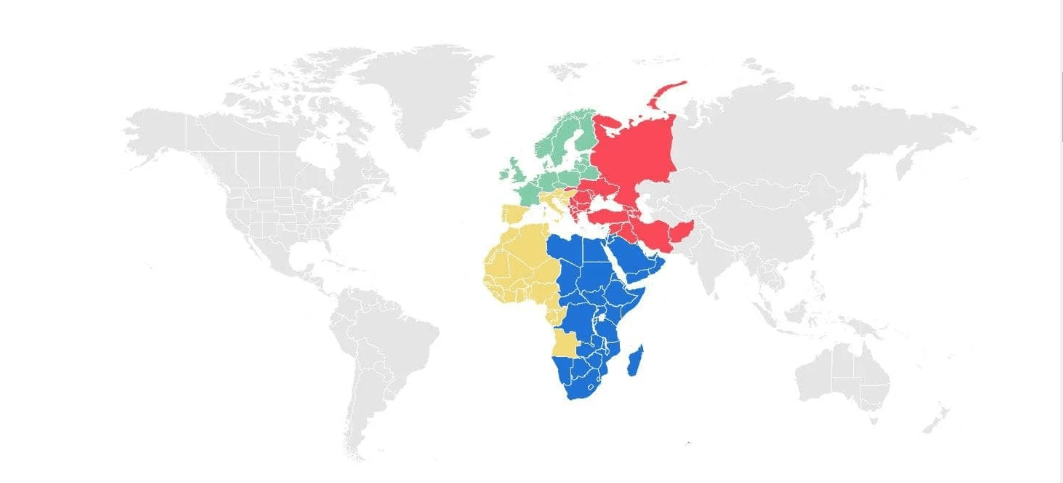Are you baffled by the term EMEA and wondering how it relates to global business? Here’s an interesting fact: EMEA stands for Europe, Middle East, and Africa – three vital regions that thousands of multinational companies focus on.
This article will unwrap the concept of EMEA, explaining its importance in business operations, countries involved, and challenges faced in this region. Ready to decode EMEA? Let’s dive in!
Key Takeaways
- EMEA stands for Europe, Middle East, and Africa – three essential regions in global business.
- The EMEA region offers vast opportunities for trade and investment with its diverse cultures and economies.
- Global corporations strategically utilize the EMEA designation to expand their operations and tap into the markets of Europe, the Middle East, and Africa.
Understanding EMEA
EMEA stands for Europe, Middle East, and Africa – a geographical grouping that is crucial in business operations and marketing.
Definition of EMEA (Europe, Middle East, and Africa)
EMEA is an acronym that stands for Europe, Middle East, and Africa – a geographic grouping used mainly by international businesses. This label acts as a shorthand designation for these regions when discussing business activities or operations.
It’s commonly utilized in marketing strategies, government reports, and institutional discourses to denote specific areas of interest or operation within a global context. The term “EMEA” covers an expansive geographical area including numerous countries with different cultures, economies, regulations, languages and time zones.
Despite its vastness and diversity, the EMEA region functions under one abbreviation to simplify conversations around multinational business strategies or market dynamics in these particular areas.

Importance of EMEA in business
EMEA plays a significant role in global business operations. The region includes some of the world’s wealthiest and most dynamic economies, offering vast opportunities for trade and investment.
Companies strategically leverage this geographical grouping to streamline their international businesses. From setting up EMEA headquarters to driving robust EMEA sales, firms maximize their reach and impact across Europe, Middle East, and Africa.
Understanding regional business activities within EMEA aids corporations in tailoring strategies that resonate with diverse cultures and economic landscapes. Therefore, incorporating an effective EMEA strategy is critical for expanding global footprints and securing market leadership.
Geographic regions included in EMEA
EMEA encompasses a vast region of the globe with diverse cultures and economies. This wide geographic grouping includes:
| Region | Countries and Territories |
|---|---|
| Northern Europe | Norway, Sweden, Finland,… |
| Western Europe | France, Germany, United Kingdom,… |
| Southern Europe | Italy, Spain, Greece,… |
| Eastern Europe | Poland, Romania, Ukraine,… |
| The Middle East | Iran, Iraq, Saudi Arabia,… |
| North Africa | Egypt, Libya, Morocco,… |
| Sub-Saharan Africa | South Africa, Nigeria,… |
Corporate Use of EMEA
Global corporations strategically utilize the EMEA designation to expand their operations and tap into the diverse markets of Europe, the Middle East, and Africa.

How global corporations utilize the EMEA designation
Global corporations strategically leverage the EMEA designation to expand their reach and tap into diverse markets. By establishing headquarters, sales offices, and operations within the EMEA region, these companies can access a vast customer base and take advantage of unique business opportunities.
This allows them to tailor their marketing strategies to cater to specific countries or regions within Europe, the Middle East, and Africa, ultimately helping these global corporations grow and thrive in this dynamic market.
Benefits of operating within the EMEA region
Operating within the EMEA region offers several benefits, including:
| Advantage | Description |
|---|---|
| Expanded Market Opportunities | Access to a diverse range of countries and consumer bases, presenting potential for business growth. |
| Access to a Skilled Workforce | Availability of highly skilled professionals across various industries. |
| Strategic Location | Proximity to Europe, the Middle East, and Africa enables easy access to multiple markets and efficient supply chains. |
| Cultural Diversity | A rich cultural heritage provides insights into varied consumer preferences and aids in tailoring marketing strategies. |
| Government Support and Incentives | Favorable business regulations, tax incentives, and grants in many EMEA countries support cost reduction and profitability enhancement. |
| Networking Opportunities | Opportunities to connect with industry players, trade associations, and institutions through various events and platforms. |
| Infrastructure Development | Investments in infrastructure improve connectivity and operational efficiency, benefiting businesses operating in the region. |
| Political Stability | Stable political environments in several EMEA countries provide a secure business foundation for international expansion. |
EMEA Countries
EMEA countries consist of several nations in Europe, the Middle East, and Africa.
List of countries included in EMEA
EMEA includes a wide range of countries from Europe, the Middle East, and Africa. These countries are:
- Albania
- Algeria
- Angola
- Austria
- Bahrain
- Belarus
- Belgium
- Benin
- Bosnia and Herzegovina
- Botswana
- Bulgaria
- Burkina Faso
- Burundi
- Cabo Verde (Cape Verde)
- Cameroon
- Central African Republic (CAR)
- Chad
- Comoros
- Congo, Democratic Republic of the Congo (Kinshasa)
- Congo, Republic of the Congo (Brazzaville)
- Cote d’Ivoire (Ivory Coast)
Alphabetical order of EMEA countries
The EMEA region consists of the following countries, listed in alphabetical order:
- Albania
- Algeria
- Angola
- Austria
- Bahrain
- Belarus
- Belgium
- Benin
- Botswana
- Bulgaria
- Burkina Faso
- Burundi
- Cameroon
- Cape Verde
- Central African Republic
- Chad
- Comoros
- Congo, Democratic Republic of the Congo (Kinshasa)
- Congo, Republic of the Congo (Brazzaville)
- Cote d’Ivoire (Ivory Coast)
Subgroupings and organizations within EMEA
Various subgroupings and organizations exist within EMEA, enhancing collaboration and business opportunities across the region. These include:
| Name | Description |
|---|---|
| European Union (EU) | Political and economic union of 27 European countries promoting cooperation, trade, and common policies. |
| Gulf Cooperation Council (GCC) | Regional intergovernmental organization consisting of six Arab states in the Persian Gulf, aiming to strengthen economic integration and political cooperation. |
| African Union (AU) | Organization comprising 55 member states across Africa, working towards political stability, economic development, and regional integration on the continent. |
| Organisation for Economic Co-operation and Development (OECD) | International organization promoting economic growth, trade, and investment among its 38 member countries, including several EMEA nations. |
| World Trade Organization (WTO) | Global forum for negotiating trade agreements and settling disputes between its 164 member countries, facilitating international trade within the EMEA region. |
| Middle East North Africa Financial Network (MENAFN) | Online platform providing financial information about businesses in the Middle East and North Africa region. |
| Nordic Council | Regional cooperation forum fostering cultural exchange and collaboration in the Nordic region, comprising several EMEA countries. |
| Economic Community of West African States (ECOWAS) | Regional organization of fifteen West African countries focusing on economic integration and development in the subregion. |
Challenges in Targeting EMEA
Corporations face difficulties navigating the cultural, economic, and regulatory differences when operating in the diverse EMEA region. Discover more about these challenges and how businesses overcome them to thrive in this dynamic market.

Difficulties faced by corporations when operating in the EMEA region
Corporations operating in the EMEA region often face various difficulties due to cultural, economic, and regulatory differences. Cultural diversity within this vast region presents challenges in terms of communication styles, business practices, and consumer preferences.
Economic variations across countries can affect market demand, pricing strategies, and supply chain management. Additionally, navigating different regulatory frameworks and compliance requirements can be complex and time-consuming for corporations operating in multiple countries within the EMEA region.
These difficulties require companies to adopt flexible approaches that account for the unique characteristics of each country while still maintaining a cohesive regional strategy.
Cultural, economic, and regulatory differences
EMEA encompasses a diverse range of countries and regions with significant cultural, economic, and regulatory differences. These differences can present challenges for corporations operating in the EMEA region. Some of the key factors to consider include:
| Factor | Description |
|---|---|
| Cultural Differences | Each country within EMEA has its own unique cultural norms, traditions, and business practices. |
| Economic Differences | The economies within the EMEA region vary greatly in terms of size, development, and industries. |
| Regulatory Differences | Each country within EMEA has its own set of laws, regulations, and business practices. |
| Language Diversity | The EMEA region comprises numerous languages, making effective communication a challenge for multinational companies. |
| Political Instability | Certain countries within the EMEA region may experience political instability or conflicts that impact business operations. |
| Trade Barriers | Trade regulations and tariffs can vary significantly across the EMEA region. |
| Currency Fluctuations | The EMEA region includes countries with different currencies or currency unions (e.g., Eurozone). |
| Infrastructure Variations | Infrastructure quality varies throughout the EMEA region, affecting transportation logistics, supply chain management, and operational efficiency. |
| Consumer Behavior | Consumer behaviors differ across countries within the EMEA region due to varying cultural influences, economic factors, and market maturity levels. |
| Legal and Ethical Considerations | Companies operating in the EMEA region must be aware of and adhere to local laws, regulations, and ethical standards. |
Related Terms and Concepts
Other related terms and concepts include the Commonwealth of Independent States (CIS) and the impact of EMEA trade on global markets. Discover more about these connections and their significance in international business.
CIS (Commonwealth of Independent States) and its connection to EMEA
The CIS, or Commonwealth of Independent States, is closely connected to the EMEA region. The CIS consists of former Soviet Union countries that have chosen to maintain economic and political ties.
This includes nations within the EMEA region such as Russia, Ukraine, Kazakhstan, and Belarus. The connection between the CIS and EMEA allows for increased trade and collaboration among these countries, creating opportunities for international businesses looking to expand into this market.
EMEA trade and its impact on global markets
EMEA trade plays a significant role in global markets. With the inclusion of Europe, the Middle East, and Africa, this vast region is home to numerous economies and industries. The trading activities within EMEA have a profound impact on global supply chains, investment flows, and market trends.
From multinational corporations expanding their operations to cross-border trade agreements being formed, EMEA’s trade dynamics shape the interconnectedness of the global economy. Understanding the intricacies of EMEA trade is crucial for businesses aiming to thrive in today’s increasingly interconnected world.
Conclusion
EMEA, which stands for Europe, Middle East, and Africa, is a geographical grouping that plays a crucial role in global business. It encompasses a wide range of countries and regions and presents both opportunities and challenges for international corporations.
Understanding EMEA’s significance can help businesses develop effective strategies to navigate this diverse market and maximize their success in the region.
Frequently Asked Questions
What does EMEA stand for?
EMEA stands for Europe, Middle East, and Africa.
Where is the EMEA region located?
The EMEA region spans across Europe, the Middle East, and Africa.
What is the purpose of EMEA?
EMEA serves as a geographic division used by businesses to manage operations, sales, and marketing strategies in Europe, the Middle East, and Africa.
How is EMEA different from other regions?
EMEA differs from other regions because it represents a combination of diverse countries from three continents with unique cultural norms and business practices.
Why is EMEA important in global business?
EMEA plays an important role in global business due to its sizeable market potential, strategic location between major economies, and access to valuable resources across multiple industries.





